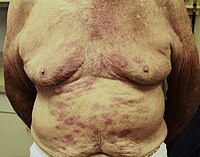
Photo from wikipedia
Introduction There is some evidence to suggest that the prevalence of atopic dermatitis (AD) in Asia is rising. We have therefore developed an algorithm for the topical treatment of AD… Click to show full abstract
Introduction There is some evidence to suggest that the prevalence of atopic dermatitis (AD) in Asia is rising. We have therefore developed an algorithm for the topical treatment of AD throughout South and East Asia for use by primary care physicians, pediatricians and dermatologists. Methods Nine AD experts from South and East Asia and one from Europe developed the algorithm based upon treatment guidelines, relevant literature and local treatment practices. The algorithm outlines current best practice for the use of emollients, topical corticosteroids (TCS) and topical calcineurin inhibitors (TCI), with the intention of simplifying the treatment regimen of mild-to-moderate AD in South and East Asia. Results Patients with AD should bathe and cleanse affected skin to remove crusts and scales daily. Emollients should also be applied daily as a maintenance treatment. When selecting appropriate topical anti-inflammatory treatment for AD flares, several factors should be taken into consideration, including the patient’s age, attitude to treatment options and site of AD lesions. Given the concerns regarding the risk of skin atrophy with use of TCS, a TCI should be used to treat AD lesions in sensitive skin areas: pimecrolimus is recommended for mild-to-moderate AD in these locations, while tacrolimus should be considered for moderate and severe cases. Either pimecrolimus or tacrolimus is recommended for flares in other, non-sensitive body locations. A proactive or intermittent maintenance treatment strategy involving regular emollient use and twice-weekly application of a TCI to previously affected areas is encouraged to reduce the risk of flares. Conclusions The algorithm proposed here is intended to simplify the topical treatment of mild-to-moderate AD in daily practice in South and East Asian countries.
Journal Title: Dermatology and Therapy
Year Published: 2020
Link to full text (if available)
Share on Social Media: Sign Up to like & get
recommendations!